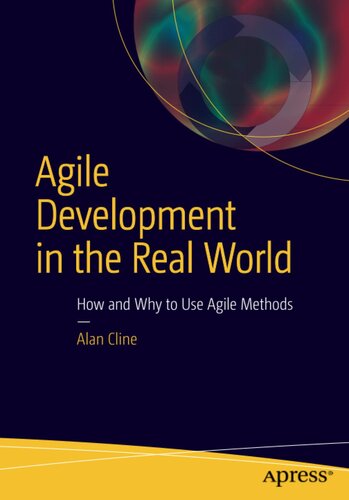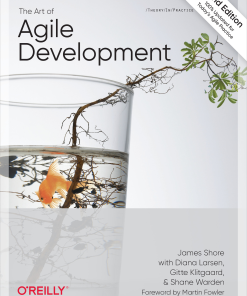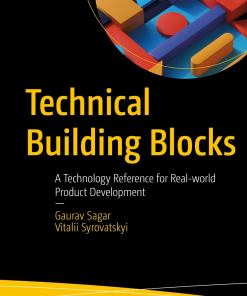Agile Development in the Real World 1st Edition by Alan Cline 9781484216798 1484216792
$50.00 Original price was: $50.00.$25.00Current price is: $25.00.
Agile Development in the Real World 1st Edition by Alan Cline – Ebook PDF Instant Download/Delivery:9781484216798, 1484216792
Full download Agile Development in the Real World 1st Edition after payment

Product details:
ISBN 10: 1484216792
ISBN 13: 9781484216798
Author: Alan Cline
This book is a practical guide for new agile practitioners and contains everything a new project manager needs to know to get up to speed with agile practices quickly and sort out the hype and dogma of pseudo-agile practices.The author lays out the general guidelines for running an agile project with the assumption that the project team may be working in a traditional environment (using the waterfall model, or something similar). Agile Development in the Real World conveys valuable insights to multiple audiences: For new-to-agile project managers, this book provides a distinctive approach that Alan Cline has used with great success, while showing the decision points and perspectives as the agile project moves forward from one step to the next. This allows new agile project managers or agile coaches to choose between the benefits of agile and the benefits of other methods. For the agile technical team member, this book contains templates and sample project artifacts to assist in learning agile techniques and to be used as exemplars for the new practitioner’s own project. For the Project Management Office (PMO), the first three chapters focus on portfolio management. They explain, for the agilists’ benefit, how projects are selected and approved, and why projects have an inherent “shelf-life” that results in hard deadlines that may seem arbitrary to traditional technical teams. What You Will Learn: How and why the evolution of project management, from PM-1 (prescriptive) to PM-2 (adaptive) affects modern 21st century project management. How sociology (stakeholder management), psychology (team dynamics), and anthropology (organizational culture) affect the way software is developed today, and why it is far more effective A clear delineation of what must to be accomplished by all the roles (PM, BA, APM, Developer, and Tester), why those roles are needed, and what they must do Step-by-step guide for a successful project based on studies and the author’s own experiences. Specific techniques for each role on the development team, both in the pre-iteration and iteration cycles, of product development. The appendices contain templates that the team could use or modify to tailor their own agile processes specific to the team, project, and organization.
Agile Development in the Real World 1st Table of contents:
Part I: Getting Started
Chapter 1: Evolution of Project Management
- Ancient Project Management
- Formal Development of Project Management
- Software Development As a Manufacturing Metaphor
- Moving Toward Software Engineering
- Software Engineering As an Immature Science
- Project Management for the Twenty-first Century
- Evolution of Agile Development
- Extreme Programming: An Early Agile Method
- Progressive Elaboration
- Effort vs. Planning by Project Method
- The Agile Manifesto: Values and Principles
- Comparing Agile and Traditional Practices
- High-Quality Product Development
- Traditional Approach
- Agile Approach
- Comparing Agile vs. Traditional Results
- PMI Parallels
- Conclusion
Chapter 2: The Birth of a Project: Portfolio Management
- Submit a Project Proposal
- Align the Proposal with Existing Business Goals
- Business Alignment
- Risk
- Return on Investment (ROI)
- Product Life Span
- Total Cost of Ownership (TCO)
- Find a Sponsor
- Build a Business Case
- Prioritize the Project Portfolio
- Project Types
- Project Selection Criteria
- Authorize the Project with a Charter
- The Project Vision and Mission
- Milestones and the Roadmap
- The Project Charter
- Review the Portfolio Periodically
- Differences with Agile
- PMI Parallels
- Conclusion
Additional Tools
- Prioritization Process Using the Delphi Technique
- Background and Motivation
- Delphi Prioritization Procedure
- Alternate Method for Secondary Passes
Chapter 3: Project Startup
- Overview
- The Project Manager
- The Product Owner
- The Business Analyst
- Manage Stakeholder Expectations
- Hold a Business Team Kickoff Meeting
- Clarify Stakeholder Relationships
- Define Roles and Responsibilities
- Stakeholder Analysis and Engagement Grid
- Build a Communication Plan
- Define Stakeholders’ Scope
- Business Abstracts
- The Project Abstract
- Workflow Context Diagram
- Meetings, Agendas, and Minutes
- Recommendations for Writing Minutes Easily
- Update the Project Charter
- Define the Features Catalog (Product Backlog)
- Prioritize the Feature Catalog
- Estimate Relative Feature Sizes
- Scoping Metrics
- Estimate the Top Part of the Features Catalog
- Develop a Preliminary Release Plan
- Iteration 0
- Hardening Iteration
- Release Iteration
- How Long Is an Iteration?
- PMI Parallels
- Conclusion
People also search for Agile Development in the Real World 1st :
what is agile development
agile development explained
agile development roles
agile development history
Tags:
Alan Cline,Agile Development,Real World
You may also like…
Biology and other natural sciences Biostatistics
Real-World Evidence in Drug Development and Evaluation 1st Edition Harry Yang
Business & Economics - Project Management
The Art of Agile Development 2nd Edition by James Shore, Shane Warden 1492080691 9781492080695
Uncategorized
Uncategorized
Medicine - Pharmacology
Biology and other natural sciences Biostatistics
Computers - Programming
Business & Economics - Management & Leadership











